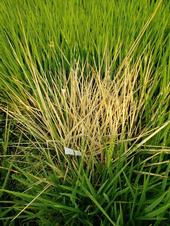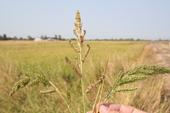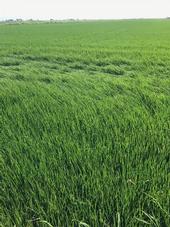- Author: Whitney Brim-DeForest
- Author: Roberta Firoved
- Posted by: Gale Perez

SUPPRESS® herbicide EC, a product manufactured by Westbridge Agricultural Products, was registered in California in 2015. Its active ingredients are Caprylic Acid and Capric Acid. It is registered for use in organic production, and it is labeled for use in “agricultural food and non-food crops”. In rice, it can be utilized only when the field is drained (no standing water allowed).
Since 2019, UCCE Rice Advisor Whitney Brim-DeForest has been testing SUPPRESS® herbicide for use in weed control in rice. In 2019, she collaborated with Jim Cook (Colusa County Farm Supply), to spot spray weedy rice in a field containing Type 3 (long awns, straw hulled). The application was made with a handheld backpack sprayer, at...
- Author: Whitney Brim-DeForest
- Posted by: Gale Perez

The UCCE Rice Team is conducting a field survey to collect watergrass samples over the next few weeks. The samples will be grown out in the greenhouse to help us start figuring out the identification and phenotypic characteristics (how to distinguish one from another) for the watergrass species found in California rice fields. The hope is that this will give us data for developing chemical and non-chemical management plans for watergrass, similar to what we have been working on with weedy rice over the past few years.
The project was funded by the California Rice Research Board, and is led by Whitney Brim-DeForest (UCCE Sutter-Yuba) and
- Author: Whitney Brim-DeForest
- Author: Roberta Firoved
- Re-posted by: Gale Perez

From the UC Rice Blog (https://ucanr.edu/blogs/blogcore/postdetail.cfm?postnum=42838)
A new herbicide is available this year for use in California rice: RebelEX®, manufactured by Corteva. It is a premix of two other well-known herbicides: Clincher® and Granite SC®, both from Corteva. The active ingredients in RebelEX® are cyhalofop (same as Clincher®) and penoxsulam (same as Granite SC®). Since it contains cyhalofop, it is important to check with your respective counties on the buffer zones and aerial application restrictions for...
- Author: Whitney Brim-DeForest
- Author: Sean Hogan
- Author: Luis Espino

For the past several years, California rice has been dealing with a pesky new weed, weedy rice aka “red” rice. Weedy rice is a difficult pest to manage, because it is the same species as rice (both are Oryza sativa L.), rendering herbicide use next-to-impossible. In the southern US rice-growing region (Texas, Louisiana, Mississippi, Missouri, Arkansas), they utilize two rice varieties (in rotation) that have been conventionally bred to tolerate the use of two herbicides: Clearfield (imazamox) and Provisia (quizalofop). Since weedy rice is susceptible to these chemicals, the entire field can be sprayed with these herbicides: the rice varieties survive, and the weedy rice is controlled. In California, these varieties...
- Author: Whitney Brim-DeForest

The 2019 Rice Weed Course will take place:
Friday, September 6, 2019
from 8:00AM to 4:10PM (Registration begins at 7:30AM)
at the
Hamilton Road Field (on West Hamilton Rd. between Hwy. 99 & Riceton Hwy.)


